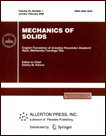 | | Mechanics of Solids
A Journal of Russian Academy of Sciences | | Founded
in January 1966
Issued 6 times a year
Print ISSN 0025-6544
Online ISSN 1934-7936 |
Archive of Issues
| Total articles in the database: | | 13362 |
| In Russian (Èçâ. ÐÀÍ. ÌÒÒ): | | 8178
|
| In English (Mech. Solids): | | 5184 |
|
| << Previous article | Volume 59, Issue 5 / 2024 | Next article >> |
| M. Honari-Torshizi, H. Moeinkhah, H. Rahmani, M.A. Mirshekar, and A. Mohammadzadeh, "Enhanced Surgical Precision in Medical Robotics through the Development of a Novel Stereotaxic Robot Design and Control System," Mech. Solids. 59 (5), 2921-2935 (2024) |
| Year |
2024 |
Volume |
59 |
Number |
5 |
Pages |
2921-2935 |
| DOI |
10.1134/S0025654424604683 |
| Title |
Enhanced Surgical Precision in Medical Robotics through the Development of a Novel Stereotaxic Robot Design and Control System |
| Author(s) |
M. Honari-Torshizi (Department of Mechanical Engineering, Shahid Nikbakht faculty, University of Sistan and Baluchestan, Zahedan, Iran)
H. Moeinkhah (Department of Mechanical Engineering, Shahid Nikbakht faculty, University of Sistan and Baluchestan, Zahedan, Iran, hmoein@eng.usb.ac.ir)
H. Rahmani (Department of Mechanical Engineering, Shahid Nikbakht faculty, University of Sistan and Baluchestan, Zahedan, Iran)
M.A. Mirshekar (Clinical Immunology Research Center, School of Medicine, Zahedan University of Medical Sciences, Zahedan, Iran; Department of Physiology, School of Medicine, Zahedan University of Medical Sciences, Zahedan, Iran)
A. Mohammadzadeh (Department of Electrical Engineering, University of Bonab, Bonab, Iran) |
| Abstract |
This paper presents a novel and innovative design for a stereotaxic robot tailored for conducting brain surgery on mice. The robotic system is capable of performing drilling, drug injection,
and implanting two electrodes simultaneously into the skull without the need for tool changes, marking a significant innovation in this field. Additionally, the control structure of this robot is a new feature not previously seen in similar examples. The analysis commences by simulating mathematically
the device using MATLAB. Subsequently, a fuzzy engine is employed to address the nonlinearities and
uncertainties of the mathematical model, acting as a compensator for the most accurate model developed in ADAMS software. The comparison between the models in ADAMS and MATLAB is based
on their behavioral similarities, each utilizing the same PID controller. Following this, the PID controller in the MATLAB model is replaced with a distinct controller. The new design is then evaluated
against the previous PID controller in terms of energy consumption, overshoot, and settling time,
demonstrating high-precision outputs when the controller is implemented. The implementation of the
new controller not only reduces energy consumption but also minimizes overshoot and settling time, thereby achieving a more stable and efficient operation during surgical procedures. |
| Keywords |
adaptive control, fuzzy compensator, genetic algorithm, linear model, optimization, stereotaxic robot |
| Received |
17 July 2024 | Revised |
09 October 2024 | Accepted |
12 October 2024 |
| Link to Fulltext |
|
| << Previous article | Volume 59, Issue 5 / 2024 | Next article >> |
|
 If you find a misprint on a webpage, please help us correct it promptly - just highlight and press Ctrl+Enter If you find a misprint on a webpage, please help us correct it promptly - just highlight and press Ctrl+Enter
|
|

 Russian
Russian  English
English